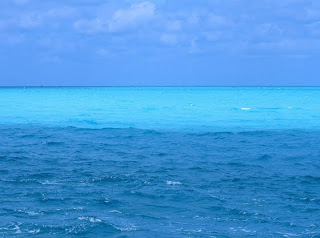earth-wealth.blogspot.com
Oceans and seas make up about 71% of the Earth's surface. The out flow of water from the land carrying sediment and dissolved substances are considered to around 90% of all sediments originated in the marine environment.
Sea water contains 32-37% o (42% o) of dissolved salts, which varies depending on climatic and local conditions (cold ocean water must have less dissolved salts from the warm sea).
The temperature of sea water depends on the climate zone (0-4oC Polar Sea, 20 to 27oC equatorial sea).
The dynamics of seas and oceans is dependent on the relationships in the solar system (the influence of moon phase, solar activity), the difference in temperature and density of sea water, changes in the atmosphere, earthquakes, volcanic activity, etc.
Tides are caused by Earth's rotation and the action of attractive forces of Moon and Sun (the solar influence is much smaller).
In the interval a little longer than 24 hours of Earth in relation to the moon turned a way to form two high and two low tides.
Triggered by the huge mass of water so the high tide sea water destroys the coast, while the abb tide pulls the destroyed material back into the sea.
Ocean currents are caused by differences in temperature and density of sea water, tidal action and winds.
The waves usually occur because of the influence of wind or air currents above the sea surface (hurricanes, typhoons), followed by the eruption of underwater volcanoes, submarine sliding and earthquakes (tsunami).
Depending on the sea depth and seabed conditions of life, the dynamics and sedimentation are distinguished:
-coastal area
-shallow area, (continental threshold),
-continental slope, or agree,
-oceanic plains
The coastal area is a tidal zone, characterized by: a steep or gentle coastline, deltas, estuaries, Lyman, lagoons.
• steep coast areas, the destruction or abrasion,
• mild flat areas of accumulation of material
The fan delta forms of river mouths formed a rapid accumulation of material transported from the mainland.Accumulation of transported material gradient is reversed, and the mouth of rivers in alluvial deposits more cuts short flows meander.In the marine environment near the land is in large sediment particles (sand), then something finer (silt and powder), and
furthest tiny particles of clay.
Estuaries are flooded river valleys open to the sea, caused by the insertion of the sea into the land. They are usually deposited sands.
Lagoon is small enclosed area filled with sea water occasionally separated from
land. They are poorly expressed due to dynamic changes of water and sediment is often expressed by evaporation sediments.
Shallow area
-Reaches 200-400 m depth,
-Divorced-relief,
--Diversity of sediment (climate, salinity, dynamics, purity limestone sea-cliffs, and biogenic sediments,
-In shallow parts formed gravel and sand deposits.
Continental slope, or agree reaches a depth of 200-400 m to 2000 -3000 m depth.
- In the area of sedimentation affect surface ocean currents and turbid (turbidity) currents at the bottom.
- Surface currents carry small floating organisms(plankton) and small particles of sediment (clay, limestone).
- Turbidity currents caused by sliding of material from the submarine slopes and carry clastic material (from dimly flow is first deposited larger, then all sorted, resulting in finer grain size, horizontally, or in the direction of current flow opaque.
- The sediments of this area are sand and gravel, marly and clayey sediments, sludges and organic ooze or sapropel, named after the Black Sea-Pontus Euxinus.


No comments:
Post a Comment